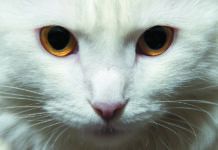Just How Much Cats Love Tight Space
Boxes, paper grocery bags, a shelf in a linen closet… if it’s a tight fit, your cat will like squeezing herself into it. The sense of security derived by felines in a close space is so strong that cats who are given a box when they arrive at a shelter calm down by day 2, according to a study conducted by researchers at Utrecht University in the Netherlands. It takes a full week to calm down for newly arrived cats who are not given boxes.
Sometimes Lip Licking is a Sign Something is Wrong
Cats often lick their lips to groom themselves after a meal. It may come from their instinct to remove the scent of prey they have just eaten, both to hide their presence from other nearby prey and also not to become prey for a larger animal. But lip licking can also signify a number of other things:
Dry Food or Wet? Which Is Right for Your Cat?
Perhaps you feed your cat dry food but have been nagged by the possibility that wet would be better for him. Sure, dry food is much less expensive and comes with a lot less muss and fuss. There are fewer trips to the store to replenish meals and less hassle because it’s just one big bag instead of a bunch of cans, pouches, or plastic trays. Not only are those a pain to lug home, but you also have to rinse them out and separate them into metals and plastics so they end up in recycling rather than landfills. Plus, wet food that is not eaten immediately can grow bacteria and become unappetizing.
Cat Having Difficulty with Urination? Some Vets Believe She May Have Pandora Syndrome
If your cat has been trying to urinate more frequently and straining in the process yet does not test positive for any disease that could lead to such symptoms, she may have what some veterinarians have historically referred to as feline idiopathic cystitis. It’s an illness diagnosed by veterinarians when they can find no other cause for the problem, which may also include leaving streams or puddles of urine outside the litter box and perhaps even urine tainted by blood.
Download The Full November 2024 Issue PDF
- Why a Cat Drools Depends on the Context
- Morsels
- Is Your Cat Getting Too Much Screen Time?
- 4 New Guidelines to Help Reduce Tension Between Cats in a Multi-Cat Household
- When the Diarrhea is Nothing to Be Concerned About; When It is.
- What’s Your Cat’s Life Expectancy?
- Could Your Cat’s Unsteadiness Be a Sign of Intervertebral Disc Disease?
- Dear Doctor
Why a Cat Drools Depends on the Context
You’re petting your cat and notice that he’s drooling along with fluttering his eyelids. Or he starts drooling while kneading you. Is something wrong?
Why Cats Are Incorrectly Perceived as Picky Eaters
A 10-pound cat may need only about 250 calories a day—very little from a human standpoint. Thus, it may seem as though she’s not eating enough, even though she is. That can lead someone to keep trying different kinds of food until the cat consumes what’s put in front of her, creating the notion that felines are finicky eaters.
Second Reason for Increased Grouchiness
It stands to reason that if a cat is in pain, he may grow grouchier. But there’s another reason an older cat may become more temperamental: dementia.
New Guidelines to Help Reduce Tension Between Cats in a Multi-Cat Household
The American Association of Feline Practitioners has come out with new Intercat Tension Guidelines: Recognition, Prevention, and Management. The aim is to help two or more cats who live together under one roof do better with each other—and to help their human family members broker peace and stability between them.
What’s Your Cat’s Life Expectancy?
There’s no doubt that life expectancy for cats continues to rise with advances in veterinary care. In one study, how long a cat was expected to live went up by more than two months for every year from 2013 to 2019. But there are differences in a cat’s life expectancy depending on certain factors.
Yes, Your Cat Has Eyelashes, Kind Of. You Just Can’t See Them.
Most cats have eyelashes, but not the way we think of lashes. They’re more like a row of relatively thick facial hairs that are the same color and length as a cat’s body hair. Because they blend in and can be hard to see, it could easily seem as though they’re missing.
Is Your Cat Getting Too Much Screen Time?
If you’re a cat in a windowless shelter, watching prey like birds or rodents scramble across a screen might be a good distraction. Research has indicated that cats in such situations enjoy having their boredom broken up with videos of varmints, fish, and the like. Older cats who can’t move around nimbly or who have failing eyesight might also benefit from apps or videos that showcase other animals.















